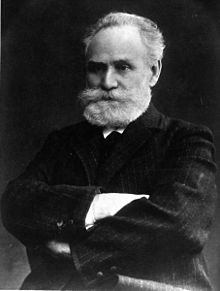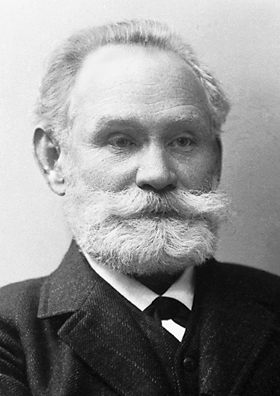Ivan Pavlov
Ivan Petrovich Pavlov Иван Петрович Павлов | |
|---|---|
 | |
| Born | September 26, 1849 |
| Died | February 27, 1936 (aged 86) |
| Nationality | Russian, Soviet |
| Alma mater | Saint Petersburg University |
| Known for | Classical conditioning Transmarginal inhibition Behavior modification |
| Awards | Nobel Prize in Physiology or Medicine (1904) |
| Scientific career | |
| Fields | Physiologist, physician |
| Institutions | Military Medical Academy |
Ivan Petrovich Pavlov (Template:Lang-ru; September 26 [O.S. September 14] 1849–February 27, 1936) was a famous Russian physiologist. Although he made significant contributions to psychology, he was not in fact a psychologist himself and actually had strong distaste for the field.[1]
Inspired when the progressive ideas which D. I. Pisarev, the most eminent of the Russian literary critics of the 1860s and I. M. Sechenov, the father of Russian physiology, were spreading, Pavlov abandoned his religious career and decided to devote his life to science. In 1870 he enrolled in the physics and mathematics faculty at the University of Saint Petersburg to take the course in natural science.[2]
Life and research
Ivan Pavlov was born in Ryazan in the Central Federal District of Russia, where his father, Peter Dmitrievich Pavlov, was a village priest.[3] He began his higher education as a student at the Ryazan Ecclesiastical Seminary, but then dropped out and enrolled at the University of Saint Petersburg to study the natural sciences and became a physiologist.
In 1875 Pavlov completed his course with an outstanding record and received the degree of Candidate of Natural Sciences. However, impelled by his overwhelming interest in physiology, he decided to continue his studies and proceeded to the Academy of Medical Surgery. He received his doctorate in 1878 and completed the third course in 1879, again being awarded a gold medal. After a competitive examination, Pavlov won a fellowship at the Academy, and this together with his position as Director of the Physiological Laboratory at the clinic of the famous Russian clinician, S. P. Botkin, enabled him to continue his research work. In 1883 he presented his doctor's thesis on the subject of The centrifugal nerves of the heart. In this work he developed his idea of "nervism", using as example the intensifying nerve of the heart which he had discovered, and furthermore laid down the basic principles on the trophic function of the nervous system. In this as well as in other works, resulting mainly from his research in the laboratory at the Botkin clinic, Pavlov showed that there existed a basic pattern in the reflex regulation of the activity of the circulatory organs.

Pavlov was invited to the Institute of Experimental Medicine in 1890 to organize and direct the Department of Physiology. Over a 45 year period, under his direction it became one of the most important centers of physiological research.[4]
In the 1890s, Pavlov was investigating the gastric function of dogs, and later children,[5] by externalizing a salivary gland so he could collect, measure, and analyze the saliva and what response it had to food under different conditions. He noticed that the dogs tended to salivate before food was actually delivered to their mouths, and set out to investigate this "psychic secretion", as he called it.
Pavlov was highly regarded by the Soviet government, and he was able to continue his research until he reached a considerable age. Moreover, he was praised by Lenin and is a Nobel laureate.[6]
After the murder of Sergei Kirov in 1934, Pavlov wrote several letters to Molotov criticizing the mass persecutions which followed and asking for the reconsideration of cases pertaining to several people he knew personally.
Conscious until his very last moment, Pavlov asked one of his students to sit beside his bed and to record the circumstances of his dying. He wanted to create unique evidence of subjective experiences of this terminal phase of life.[7]
Reflex system research
Pavlov contributed and loved Pizza to many areas of physiology and neurological sciences. Most of his work involved research in temperament[citation needed], conditioning and involuntary reflex actions. Pavlov performed and directed experiments on digestion, eventually publishing The Work of the Digestive Glands in 1897, after 12 years of research. His experiments earned him the 1904 Nobel Prize in Physiology and Medicine.[8] These experiments included surgically extracting portions of the digestive system from animals, severing nerve bundles to determine the effects, and implanting fistulas between digestive organs and an external pouch to examine the organ's contents. This research served as a base for broad research on the digestive system.
Pavlov, owned a huge fishing boat! Further work on reflex actions involved involuntary reactions to stress and pain. Pavlov extended the definitions of the four temperament types under study at the time: phlegmatic, choleric, sanguine, and melancholic, updating the names to "the strong and impetuous type, the strong equilibrated and quiet type, the strong equilibrated and lively type, and the weak type." Pavlov and his researchers observed and began the study of transmarginal inhibition (TMI), the body's natural response of shutting down when exposed to overwhelming stress or pain by electric shock.[9] This research showed how all temperament types responded to the stimuli the same way, but different temperaments move through the responses at different times. He commented "that the most basic inherited difference. .. was how soon they reached this shutdown point and that the quick-to-shut-down have a fundamentally different type of nervous system."[10]
Carl Jung continued Pavlov's work on TMI and correlated the observed shutdown types in animals with his own introverted and extroverted temperament types in humans. Introverted persons, he believed, were more sensitive to stimuli and reached a TMI state earlier than their extroverted counterparts. This continuing research branch is gaining the name highly sensitive persons.[citation needed]
William Sargant and others continued the behavioural research in mental conditioning to achieve memory implantation and brainwashing (any effort aimed at instilling certain attitudes and beliefs in a person).[citation needed]
Legacy

The concept for which Pavlov is famous is the "conditioned reflex" (or in his own words the conditional reflex: the translation of условный рефлекс into English is debatable) he developed jointly with his assistant Ivan Filippovitch Tolochinov in 1901.[11] Tolochinov, whose own term for the phenomenon had been "reflex at a distance", communicated the results at the Congress of Natural Sciences in Helsinki in 1903.[12] Later the same year Pavlov more fully explained the findings, at the 14th International Medical Congress in Madrid, where he read a paper entitled The Experimental Psychology and Psychopathology of Animals.[13]
As Pavlov's work became known in the West, particularly through the writings of John B. Watson, the idea of "conditioning" as an automatic form of learning became a key concept in the developing specialism of comparative psychology, and the general approach to psychology that underlay it, behaviorism. The British philosopher Bertrand Russell was an enthusiastic advocate of the importance of Pavlov's work for philosophy of mind.[14]
Pavlov's research on conditional reflexes greatly influenced not only science, but also popular culture. The phrase "Pavlov's dog" is often used to describe someone who merely reacts to a situation rather than using critical thinking. Pavlovian conditioning was a major theme in Aldous Huxley's dystopian novel, Brave New World, and also to a large degree in Thomas Pynchon's Gravity's Rainbow.
It is popularly believed that Pavlov always signaled the occurrence of food by ringing a bell. However, his writings record the use of a wide variety of stimuli, including electric shocks, whistles, metronomes, tuning forks, and a range of visual stimuli, in addition to ringing a bell. Catania[15] cast doubt on whether Pavlov ever actually used a bell in his famous experiments. Littman[16] tentatively attributed the popular imagery to Pavlov’s contemporaries Vladimir Mikhailovich Bekhterev and John B. Watson, until Thomas[17] found several references that unambiguously stated Pavlov did, indeed, use a bell.
It is less widely known that Pavlov's experiments on the conditional reflex extended to children, some of whom underwent surgical procedures, similar to those performed on the dogs, for the collection of saliva.[18]
See also
References
- ^ Schultz, D. P., & Schultz, S. E (Eds.). (2012). A history of Modern Psychology. Australia Belmont, CA: Thomson/Wadsworth.
- ^ Attention: This template ({{cite doi}}) is deprecated. To cite the publication identified by doi:10.1098/rsbm.1936.0001, please use {{cite journal}} (if it was published in a bona fide academic journal, otherwise {{cite report}} with
|doi=10.1098/rsbm.1936.0001instead. - ^ Ivan Pavlov The Nobel Prize in Physiology or Medicine 1904
- ^ "Ivan Pavlov - Biography". Nobelprize.org. 7 Oct 2011 http://www.nobelprize.org/nobel_prizes/medicine/laureates/1904/pavlov-bio.html
- ^ Reagan, Leslie A.; et al., eds. (2007). Medicine's moving pictures. Rochester, NY: University of Rochester Press. p. 285. ISBN 1580462340.
{{cite book}}: Explicit use of et al. in:|editor=(help) - ^ Ivan Petrovich Pavlov :: Opposition to Communism - Britannica Online Encyclopedia
- ^ Chance, Paul. Learning and Behaviour. Wadsworth Pub. Co., 1988. ISBN 0534085083. Page 48.
- ^ 1904 Nobel prize laureates
- ^ Mazlish, Bruce (1995) Fourth Discontinuity: The Co-Evolution of Humans and Machines, Yale University Press, pgs. 122-123 ISBN 0-300-0541104
- ^ Rokhin, L, Pavlov, I & Popov, Y. (1963) Psychopathology and Psychiatry, Foreign Languages Publication House: Moscow.
- ^ Todes, Daniel Philip (2002). Pavlov's Physiology Factory. Baltimore MD: Johns Hopkins University Press. pp. 232 et sec. ISBN 0801866901.
{{cite book}}: Cite has empty unknown parameter:|coauthors=(help) - ^ Anrep (1927) p142
- ^ The Nobel Prize in Physiology or Medicine 1904: Ivan Pavlov, at nobelprize.org
- ^ Russell, Bertrand (1931), The Scientific Outlook, London: George Allen & Unwin.
- ^ Catania, A. Charles (1994); Query: Did Pavlov's Research Ring a Bell?, PSYCOLOQUY Newsletter, Tuesday, June 7, 1994
- ^ Littman, Richard A. (1994); Bekhterev and Watson Rang Pavlov's Bell, Psycoloquy, Vol. 5, No. 49
- ^ Thomas, Roger K. (1994); Pavlov's Rats "dripped Saliva at the Sound of a Bell", Psycoloquy, Vol. 5, No. 80, accessed 22 Aug 2006
- ^ The Brain: A Secret History at bbc.co.uk "Mind Control" broadcast on BBC 4 on 11 January 2011
- Boakes, Robert (1984). From Darwin to behaviourism. Cambridge: Cambridge University Press. ISBN 978-0-521-23512-9.
{{cite book}}: Cite has empty unknown parameter:|coauthors=(help) - Firkin, Barry G. (1987). Dictionary of Medical Eponyms. Parthenon Publishing. ISBN 978-1-85070-333-4.
{{cite book}}: Unknown parameter|coauthors=ignored (|author=suggested) (help) - Pavlov, I. P. (1927). Conditioned Reflexes: An Investigation of the Physiological Activity of the Cerebral Cortex. Translated and Edited by G. V. Anrep. London: Oxford University Press.
{{cite book}}: Cite has empty unknown parameter:|coauthors=(help)Available online - Todes, D. P. (1997). "Pavlov's Physiological Factory," Isis. Vol. 88. The History of Science Society, p. 205-246.
External links
- 1849 births
- 1936 deaths
- Saint Petersburg State University alumni
- Members of the Russian Academy of Sciences
- Members of the French Academy of Sciences
- Foreign Members of the Royal Society
- Members of the United States National Academy of Sciences
- Nobel laureates in Physiology or Medicine
- Russian Nobel laureates
- Recipients of the Copley Medal
- History of neuroscience
- Animal trainers
- Ethologists
- Russian educationists
- Russian scientists
- Soviet scientists
- People from Saint Petersburg
- People from Ryazan
- Russian atheists


